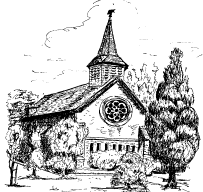|
|
|
|
Great Warley Church,
Essex |

The Parish Church of St Mary the Virgin, Great Warley,
Essex
was built on land given to the parish by Evelyn Heseltine. His great
grandfather's brother was my great great great grandfather.
In fact, Evelyn Heseltine went a great deal further than
that, by providing the capital necessary for the work to be carried out, to
the tune of somewhat over £5,000 - a sum probably in excess of £2.75 million
by today's (2004) standards.

Visit the church web site
and read more of the history and description.

|
|
Contents
|
The Old Church
The
original church of St Mary in Great Warley was sited much further south than
its replacement; across the A 127, at the end of Church Lane, and
immediately south of Great Warley Hall. Only some of its gravestones now
remain, the tower having stood until sometime prior to 1973.
Descriptions of the
church[i]
prior to 1730 are sparse, but the first Rector is recorded as John le
Norreis in 1247, no doubt appointed by the Abbess
of Barking into whose Abbey the ownership of the Manor of Warley passed. The
village was then called Warley Abbess.
In
the time of Henry VIII, in 1548, Protestants who had gained the upper hand
against the Catholics went about selling church property, the latten
candlesticks at Great Warley being no exception. However, it is also
recorded that the income from the sale, some 29s. 2d., was expended on
repairs to the fabric of the church. A record from 1681 states that the arms
of the Commonwealth were still visible on the walls of the church.
Some time before 1730
the tower of the church was struck by lightning and destroyed; it was
replaced by a shingled and capped wooden structure constructed upon the old
foundations. It then contained three bells. Framed copies of the Ten
Commandments, the Creed and the Lord’s Prayer were hung in the church in
1744, and those, together with the King’s Arms, were still in place in 1810.
Repairs to the church
walls and the tower were carried out in 1803, and in 1833 a west gallery was
constructed at the behest of Mrs Robinson, the then Rector’s wife, a north
gallery already being in place. The lack of additional seating in the church
continued to present a problem, and in 1851 the church was reported as
“totally inadequate”[ii] for the needs of a growing parish.[iii] As a result of this, Sarah Clay, the Rector’s sister-in-law, gave
£1,000 to endow a new church, this being Christ Church, Warley. This was
also built with a west gallery, removed only in 1956, when its door was
replaced by a window.[iv]
Old age and nature
took its course, for in 1858 the chancel collapsed.[v] Thus, during the period 1858-60 the church was remodelled, the
design being entrusted to the architect
Samuel Sanders Teulon. The chancel was rebuilt in yellow brick with
stone dressings, the north vestry added, and the west tower was
reconstructed in red brick, all at a total cost of £1,000.[vi]
‘Remodelled’ is of
course a euphemism for the stripping of the original fittings and furniture
and the removal of the old quire which no doubt had resided in the west
gallery so thoughtfully provided by Mrs Robinson – possibly also in the
north gallery which pre-dated it. Having said that, although the original
high-sided box pews and possibly a three-decker pulpit was removed along
with the west gallery, a new west gallery[vii]
was built at the west end of the church, the photograph at the back of the
present church showing an external staircase leading to it against the south
wall of the tower.[viii]
|
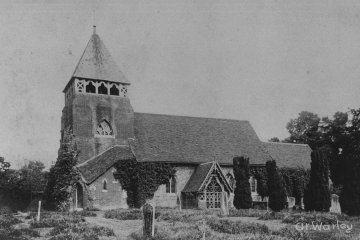 |
|
|
Copy of an old Photograph on the west wall of the new St
Mary's Church, Great Warley, showing the external staircase to the
musicians' gallery which was at the westr end of the old St Mary's Church. A
similar picture can be found in Andrew Barham's excellent book Lost
Parish Churches of Essex. |
|
As the village centre
moved to the higher ground, where it lies today, the old
church started to fall
into further disrepair.
Although
attempts were made to obtain a faculty for the remodelling of the tower,
removal of the nave and re-building the chancel (presumably to replace the
demolished nave and thereby make a smaller chapel) funding from the patrons
of the living, St John's College, Cambridge, was turned down and the scheme
faltered.
By
1923 the old church had recently been pulled down, but the tower was still
standing in 1953, although, as stated above, it had fallen by 1975.[ix]

As a result, Rector
Bailey built a wooden church in the grounds of his home "Fairsteads", and
the old church ceased to be used for services other than funerals. This
‘mission’ church seated some 140 people when first licensed for use in 1892.
This lasted until the new church was built in 1902-04, and on his death, the
temporary church was bequeathed by him to the parish of Baildon in Yorkshire.
It was taken down and re-erected there.
|
|
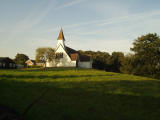 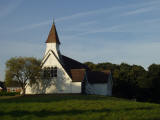
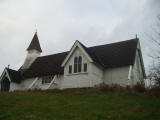
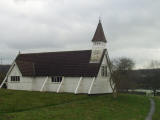 |
|
Pictures of
the interim church in its new home in Baildon, Yorkshire.
|
|
The book,
Baildon Memories by Lucy L Gill, (published by MTD Rigg Publications, 1A
Renton Avenue, Guiseley, Leeds) says that the church, St James', was
brought to Baildon in 1905 from Great Warley, Essex.
The Rev'd N R Bailey, rector of Great Warley, had property in Baildon and
hoped to retire there. However his obituary was published in Nov 1900 before
he retired. It is part of the Baildon Parish, which I believe is one of the
largest in the country and has 3 parish churches in addition to the
Moravian, Methodist and Roman Catholic churches.
The church is in the space between Otley Road, Kirklands Lane and Hoyle Court Rd in Baildon, as can be
seen on this map at:
http://www.multimap.com/map
[pictures and information courtesy of Paul Marfell and the Marfell
Nuke Site at www.marfell.me.uk]

|
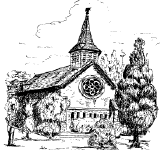 The new church is
thought by many to be the foremost example of the Art Nouveau or ‘Arts
& Crafts’ style, and is one of only three in existence today. Listed as
an historical building with Grade 1 status, and with its Lychgate as Grade 2
listed status, it is the best preserved of the three, even though it
suffered bomb damage during World War II when all the most important windows
were blown out, and suffered serious vandalism in the 1970s. The new church is
thought by many to be the foremost example of the Art Nouveau or ‘Arts
& Crafts’ style, and is one of only three in existence today. Listed as
an historical building with Grade 1 status, and with its Lychgate as Grade 2
listed status, it is the best preserved of the three, even though it
suffered bomb damage during World War II when all the most important windows
were blown out, and suffered serious vandalism in the 1970s.
Evelyn Heseltine, who
by the turn of the century had been resident in Great Warley for some 25
years, and had purchased a small house called Goldings[x]
which he had enlarged substantially during the 1880s, donated both the site
for the new church and some £5,000 for its building. The design and
furnishing were under the control of the architect,
Charles
Harrison Townsend, and the sculptor and interior designer,
William Reynolds-Stephens, (who was subsequently
knighted and became President of the Royal British Society of Sculptors),
both of whom had the experience and flair to reproduce
faithfully the then very modern and
contemporary Art
Nouveau style for
the interior.
The consecration of the
new church was carried out on 1st June
1904 by the Lord Bishop of St. Albans, following which it was constituted
as the Parish Church
by an Instrument of the Ecclesiastical Commissioners and duly published in
the London Gazette dated August 14th
1904.
Since then the church has been damaged in
a number of ways: on the night of 21st September 1940 a bomb fell some 25
yards to the north-west of the church, causing great damage to the
stained-glass windows, the ceiling of the organ-chamber and the church
doors. These have been slowly replaced over the years, war damage
compensation only partially covering the cost of repair. In November 1972 a
bout of particularly vicious vandalism caused considerable damage (but not
nearly so badly as at the neighbouring church of Childerditch),
and in June 1975 the stained-glass windows at St Mary's were again attacked
on three separate occasions. All this has had to be repaired.[xi]
|
|
When the church was dedicated in 1904, a commemorative booklet explained the
theme of the design as follows:[xii]
‘The primary object of
Mr Reynolds-Stephens in his designs has been to lead the thoughts of the
worshippers onward through his decorations to the glorified and risen
Christ, whose form in the centre of the reredos is to be the keystone of the
whole scheme’.
In that he has
certainly succeeded, and one’s attention is automatically and constantly
drawn back to the triptych which stands above the altar, at the focal point
of the apsidal sanctuary. Constructed from a variety of materials – bronze,
silver gilt, ormolu, enamel, mother-of-pearl and marble – in the centre
panel Christ stands on the coiled serpent and with right hand raised in the
great blessing “My peace I give to you”, which is inscribed underneath.
In the rounded arch in
which Christ stands, the keystone is inscribed ‘IHS’ – Jesus Hominum
Salvator – and the four Evangelists are denoted by their Biblical signs. In
the ormolo panels on either side are depicted the Nativity and the
Entombment. These panels, together with the central figure of Christ are
themselves in the form of a cross, and the panels are supported on
triple-stemmed rose trees in bronze, with mother of pearl roses, the whole
being framed in marble. The vault of the apse over the Sanctuary is finished
in aluminium leaf, with a Vine rising in four places from a central branch
which runs round the cornice depicting seraphs. The fruit is picked out in
red.
Materials used for the
interior are a mixture of various metals, marbles, and mother of pearl,
together with the walnut furniture. There is much evidence all
around of the
Art and Craft movement and of the influence of the pre-Raphaelites. Indeed,
locally, it is popularly known as the "Pearl Church", because of the widely
used mother of pearl decoration. Such is the decoration and the attention to
detail wherever you look, that it is almost impossible to do the furnishings
justice by verbal description. The
rood screen and the organ case are just two of the many details which cause
the visitor to stand and stare.
|
|
Read about the
West Gallery Music associated with the old church at Great Warley and the
local composer, John Arnold here. |

[i]
Much of this information is loosely rewritten from information in
Victoria County History, Essex, Volume 6. In turn, this has been
gleaned from the following sources: E.R.O., D/P 195/1/2 (cuttings and
illustrations), 195/5, 195/8/1-3; T/P 195/2; History of Great Warley,
9-10; Thorne, Environs Lond. 678; photo in St Mary the Virgin
Church, Great Warley.
[iii]
Population figures: 1801, 430; rose during the period to 1821, but in
1831 was recorded as 424; 1841, 596; 1851, 952. The nearby barracks,
built in 1805, were reopened in 1843 and the married quarters were
situated in Great Warley parish.
[iv]
E.R.O. D/CF
95/119. It sounds as if there was also an external stair here to gain
access to the gallery.
[vii]
or was it in fact that the previous one was not demolished?
[viii] Church Bells of
Essex, 439.
[ix]
History of Great Warley, 19; cf. Kelley’s Directory for Essex
(1914, 1926, 1933); RCHM Essex, iv. 61.
[x]
E.R.O. Sale Catalogue B5742.

|
|

